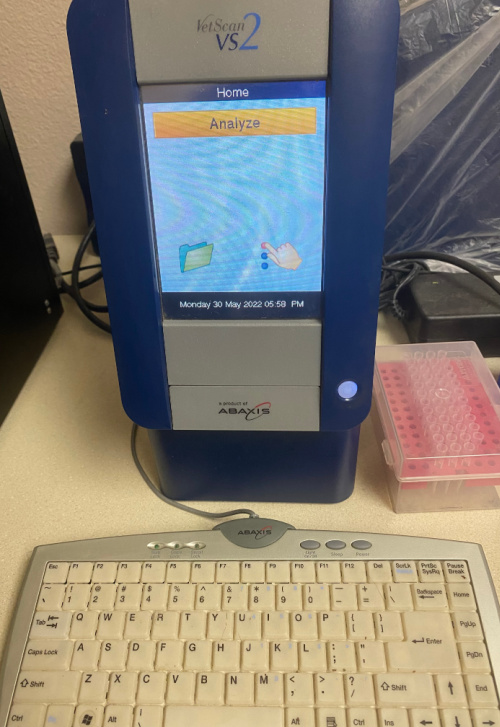These terms can be confusing so hoping to change that for my readers. These terms will be used in human medicine as well. Both comp and profile are shorter versions of comprehensive metabolic panels that offer an inside look at your body’s chemical balance and metabolism. The values are screening numbers and can be compared from year to year to monitor disease processes. These tests are extremely important prior to elective procedures to assess anesthetic risk. Profiles are used prior to starting long term medications and at times of illness. There are different comp panels that include various lab tests. Our standard panel has 14 different markers and we can add 3 additional tests if warranted. I want to list each of these and give a description of how they are used so you can learn what these mean if your furry friend ever needs a comp or profile.
| TP | Total Protein | sum of all proteins in the blood – main two types are albumin and globulins |
| ALB | albumin | most common protein and keeps fluids from leaking out of the blood and can carry other substances throughout the body |
| GLOB | globulin | these proteins are formed by the immune system and liver |
| GLOB + ALB = TP | therefore we can do A/G ratios that can give insight to other health concerns | |
| ALP | Alkaline Phosphatase | found in bone and liver so if elevated this is not a diagnosis — other tests will need to be performed — medications can elevate this enzyme also |
| ALT | Alanine Transaminase | enzyme exclusively in the liver cells — when elevated we know we need to focus on the liver. |
| TBil | Total Bilirubin | measure of bilibruin in your blood — animals can have yellow coloring of skin, and the whites of the eyes — urine will look dark like coffee grounds — jaundice if elevated and above normal — concern for liver if changes are noted |
| AMY | Amylase | this enzyme is made in the pancreas – with disease or injury to pancreas we see increases of this enzyme in the blood |
| BUN | Blood Urea Nitrogen | a measurement of urea in your blood — important information about kidney function — if low can be indicative of lack of protein in your diet or liver concerns |
| CRE | creatinine | high levels correlate with lack of normal kidney function — kidney’s filter CRE from your blood and excretes in urine — if kidneys are not working CRE will increase in blood |
| GLU | Glucose | extremely high levels can indicate diabetes — can be mildly elevated if an animal is stressed — low levels can lead to comas and disorientation — in puppies and kittens if their glucose is low — people often assume they are dead because they are unresponsive |
| Ca | calcium | diet can impact calcium levels — high levels can also be driven by cancer and kidney disease — low calcium levels can be seen with low albumin levels caused by nutrition — liver or kidney disease, infections, or other long term illnesses |
| Phos | phosphorus | low levels are often caused by malnutrition over long periods of time — this may be the diet or the lack of sufficient food intake — elevated levels can appear with kidney disease in cats and dogs — the kidneys regulate the phosphorus levels |
| Na+ | sodium | electrolytes such as Na+ are necessary for heart and brain function, fluid balance, to deliver oxygen — it regulates blood pressure, blood volume, and transmission of nerve impulses — changes in Na+ also impact Cl- (chloride levels) another electrolyte |
| K+ | potassium | K+ is an electrolyte that is needed to control brain and heart activity along with nerve impulses — it is present in the cells and blood of a pet’s body — low K+ levels are often seen in advanced kidney disease — high K+ levels are seen in cases of urinary tract rupture, adrenal gland disorder, heart arrythmias, trauma, and many other conditions |
Add on tests we can consider if needed are as follows:
| Chol | cholesterol | there are breeds of dogs that may have a genetic disposition to high cholesterol levels (schnauzers, Shetland sheepdog, collies) — high chol could indicate diabetes cushings, or low thyroid levels — low levels can indicate loss through the digestive tract with intestinal diseases or cancer |
| T-4 | thyroid | elevated levels in pets often indicates cancer of the thyroid gland — it is most common in older cats and rare in dogs — low thyroid levels are rare in cats and more common in dogs — dogs treated for low thyroid conditions usually owners see an increase in their energy level, improved skin and hair, and weight loss |
| SDMA | symmetric dimethylarginine | this test detects kidney disease at an early stage then the creatine level can |
These tests can be run daily. Results are available the same day. This allows us to start therapy and treatment as quickly as possible. If you ever have concerns about your pet, please do not hesitate to contact us. The sooner a diagnosis is made the better the outcome for our pets.

